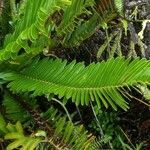Plants terrestrial. Rhizome erect or decumbent, to 900 mm long, to 100 mm in diameter, closely set with roots, crowded persistent stipe bases and scales, scales chartaceous, concolorous and/or bicolorous, bicolorous scales ferrugineous to stramineous with a castaneous, narrow central stripe, sessile, lanceolate-flagelliform to linear-attenuate, cordate to cordate-imbricate, entire or with a few short marginal outgrowths near the base, apex terminates in an oblong thin-walled cell, to 23 mm long, to 3 mm wide. Fronds crowded, caespitose, erect, dimorphic, fertile usually overtop the sterile, sterile to 1.2 m long, fertile to 1.25 m long; stipe rigid, proximally castaneous, stramineous higher up, adaxially sulcate, sterile to 60 mm long, to 6 mm in diameter, fertile to 110 mm long, to 8 mm in diameter, set with unicellular cylindrical glands to 112 µm long, and scales, smaller scales filiform, larger scales similar to those on the rhizome; lamina 1-pinnate, sterile oblong-obtuse to oblong-acute, gradually reduced towards the base, basal pinnae widely spaced, more closely spaced and often imbricate towards the apex, to 1.1 m long, to 300 mm wide, with up to 14 free pinna pairs, fertile oblong-obtuse, gradually reduced towards the base, basal pinnae widely spaced, more closely spaced to crowded higher up, to 1.14 m long, to 230 mm wide, with up to 42 pinna pairs; rachis firm, stramineous, adaxially sulcate, sulcus not open to that of the costae, pronounced abaxially, variously set with glands and scales similar to those on the stipe; pinnae coriaceous, pale green, sterile sessile, oblong-cuneate, entire, base inequilateral, acroscopically narrowly cuneate, basiscopically cuneate to obtuse, gradually basiscopically decurrent along the rachis towards the apex, to 190 mm long, to 17 mm wide, fertile sessile, linear, to 215 mm long, to 4 mm wide, adaxially with scattered unicellular cylindrical glands to 112 µm long, abaxially with glands and scales, scales initially closely set along the costa, chartaceous, ferrugineous to stramineous, sessile, lanceolate-flagelliform to filiform, cordate to narrowly cuneate, entire, or irregularly set with scattered marginal outgrowths, apex terminates in an oblong thin-walled cell, to 11 mm long, to 0.5 mm wide; costa adaxially shallowly sulcate. Venation adaxially obscure, evident abaxially, forked, in the sterile, free branches end near the margin, in the fertile the veins anastomose to form a continuous near-marginal vascular commissure. Sori linear, extending most of the pinna length; indusium firmly chartaceous, brown, near-marginal, linear, lacerate; sporangium long-stalked, simple, 3-seriate below capsule, capsule broadly elliptic in lateral view, with (16-)19(-20) indurated annulus cells, epistomium (6-)7(-9)-celled, hypostomium (4-)6(-8)-celled. Spores 64 per sporangium, brown, elliptic, monolete, with low reticulate ridges, granulate, (58-)63.29(-72) x (46-)49.52(-54) µm.
More
Rhizome erect or decumbent, up to 900 mm long, up to 100 mm in diam., with stipe bases and concolorous and/or bicolorous, lanceolate-flagelliform to linear-attenuate scales, up to 23 x 3 mm, entire or with short outgrowths near base. Fronds caespitose, erect, dimorphic, the fertile usually overtop the sterile; sterile up to 1.2 m long; fertile up to 1.25 m long. Stipe rigid, proximally castaneous; sterile up to 60 mm long, up to 6 mm in diam.; fertile up to 110 mm long, up to 8 mm in diam., with glands and scales. Lamina 1-pinnate; sterile oblong-obtuse to oblong-acute, up to 1100 m x 300 mm, with up to 14 free pinna pairs; fertile oblong-obtuse, up to 1140 m x 230 mm, with up to 42 pinna pairs. Pinnae coriaceous; sterile oblong-cuneate, up to 190 x 17 mm, entire; fertile linear, up to 215 x 4 mm, adaxially with glands, abaxially with glands and scales; scales initially closely set along costa, ferruginous to stramineous, lanceolate-flagelliform to filiform, up to 11 x 0.5 mm, entire or with scattered outgrowths. Sori linear, extending most of pinna length. Indusium near-marginal, linear, lacerate.
Rhizome erect or procumbent, up to 0.9 m long and 0.1 m in diameter, set with very narrowly linear-attenuate, entire rhizome-scales up to 35 mm long with a dark brown to ebeneous central stripe and pale borders. Fronds erect to suberect, coriaceous, dimorphous; stipe pale brown, with a conspicuous tuft of scales basally; lamina narrowly oblong, acute, up to 1.4 x 0.36 m, with a narrowly oblong acute terminal segment, base with up to 9 pairs of gradually reduced pinnae, the lowest rudimentary; sterile pinnae subsessile with an unequally cuneate base, entire, usually revolute, upper surface glabrous, lower surface set with hairlike scales and with ovate-fimbriate scales along costa; fertile pinnae subsessile to very shortly petiolate. Sori extending almost the whole length of fertile pinnae; indusium pale brown, linear, lacerate at maturity, c. 1.5 mm broad.
Perennial with thick, erect rhizome. Fronds erect to suberect, coriaceous, to 1.6 m long, stipe proximally scaled, lamina coriaceous, narrowly oblong, to 1.4 m long, 1-pinnate, sterile pinnae subsessile, entire, fertile pinnae subsessile to shortly petiolate. Sori extending most of the length of the fertile pinnae, indusium lacerate.
Rhizome erect or procumbent, set with linear-attenuate rhizome scales up to 35 mm long. Sterile pinna with margin entire to the naked eye, unequally cuneate basally, never auriculate, seldom petiolate. Sterile lamina up to 1.4 x 0.36 m. Fertile pinnae subsessile to very shortly petiolate.
Terrestrial, on moist rocky slope in savannah grassland; 5, 000 to 5, 400 ft. alt.

